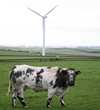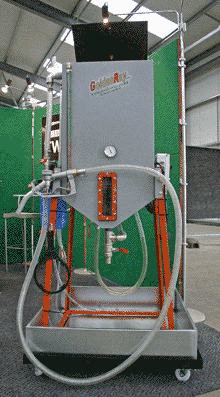New renewable power kit at Farm Energy Event

Producing your own energy on farm might seem daunting, but it doesn’t have to be as complicated as it sounds. Plenty of advice and clever kit was on show at last week’s Farm Energy Event. Nick Fone reports
 |
|---|
| Farmers must look to other waste streams to feed digesters, says Spreadwise’s Mark Roberts. The firm now markets German firm UTS’s biogas systems including this hydraulically-driven agitator. |
With increasingly unpredictable fossil-fuel prices and government policies to support green energy providers, there’s never been a better time to start looking into renewables as an alternative income stream for the farm.
That’s the message from the NFU’s chief energy adviser, Dr Jonathan Scunlock, who believes there is a big future for farmers in helping the UK to meet government targets.
“Crazy fluctuations in energy prices, triggered by the fact that world oil production is at its peak, mean we have to look to alternative sources,” he says.
“In the next 12 years there will have to be a tenfold increase in renewable energy production if the government is to fulfil its promises.
“This provides a massive opportunity for farmers. On-farm energy production can stabilise energy costs, provide a diversification income and is a way to demonstrate that farmers are working to reduce their carbon footprint.”
This last point will become particularly important, says Dr Scunlock. Over time, he expects consumers and food retailers to start looking for climate-friendly foods, which will inevitably lead to some form of carbon footprint measurement for producers.
So what kit is available for farms that want to venture into the world of green energy production?
BIOGAS
Much talk at the event centred on biogas production plants, all of which require significant investment.
German firm EnviTec has more than 300 farm-scale units up and running across Europe and a number in the planning phase for the UK. Depending on the system used, prices range from £1.2m for a 500kW plant to £2.4m for one with an output of 1MW, so these are still big schemes.
Income from electricity is currently about 8p/kWh with a top-up of 4-5p/kWh from Renewable Obligation Certificates (ROCs). It is proposed that this payment will double from April.
Slurry handling and spreading specialist Spreadwise has teamed up with another German firm, UTS Biogas, to offer anaerobic digestion units to farmers. It predicts that for an investment of less than £1m, a 600-cow dairy herd could expect to see better returns from its electricity sales than from its milk, particularly when other waste streams are taken in for a gate fee.
“We don’t see a future in growing crops just to feed a digester,” says the firm’s Mark Roberts.
“A typical 300-head dairy herd running across 300-400 acres will need every blade of grass they can lay their hands on. They need to be looking at things like green wastes and food waste.”
He also points out that most herds produce far more slurry through the winter months than through summer, so gas production could be quite seasonal without other sources of material.
Clarke Energy markets Haase combined heat and power (CHP) plants in the UK.
As well as standard biogas digesters, the company also builds small-scale refineries to clean up and concentrate the methane produced to make the grade for sale to LPG car drivers or direct to the national gas network. They are capable of processing 650cu m of gas an hour and the price for the biogas upgrader is currently about £1.8m.
BIOMASS
Equipment Supply Services offers the US-built range of big-scale Rotochopper wood-grinders to produce chip for biomass boilers and power stations. The smallest has a 250hp engine, costs £120,000 and will churn out up to 18-20t/hour while the largest, at £350,000, packs a 750hp punch and reaches 50t/hour. The company also offers a range of static and mobile bale shredders for straw-burning plants.
WIND
ICE Renewables offers a wide range of green energy options, including wind turbines. A typical farm-scale unit will produce 300MWh each year. It will cost about £250,000, with capital allowances reducing that figure to nearer £200,000. Total annual revenue or cost savings range from £30,000 to £47,000, making for a payback period of four to seven years.
| BIODIESEL
|
|---|
HEATING
Domestic heating systems can be altered to reduced energy usage. One way of doing this is with a ground-source or air-source heat pump. Effectively using a refrigeration circuit in reverse, these harness the latent heat of the soil or ambient air and concentrate it to heat water to about 50C.ICE Energy’s ground-source system for a typical four-bedroom house costs £6000 and will last 25-30 years. An air-source system takes up less space and is about half the cost. with a life expectancy of 12-15 years.
GRANTS
The Rural Development Plan for England has £600m to distribute to projects over the next five years. Those that have a clear focus on renewable energy could receive up to 50% funding. Advice is available from regional offices outlined on the DEFRA website – www.defra.gov.uk/rural/rdpe

 Golden Ray
Golden Ray